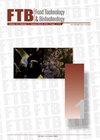Chemical Characterization and Antioxidant Potential of the Rowan Fruits (Sorbus aucuparia L.) from Alpine-Dinaric region of Croatia
IF 2.5
4区 农林科学
Q3 BIOTECHNOLOGY & APPLIED MICROBIOLOGY
引用次数: 0
Abstract
Research background. The rowan (Sorbus aucuparia L.) is a small tree in the Rosaceae family with characteristic orange-red fruits. Raw fruits can be used for making jams, juices, and puree, as well as dried ones for teas. In folk medicine, they were used to prevent scurvy and bleeding or as a diuretic and laxative. The aim of this study was to characterize the proximate chemical composition, antioxidant potential, and macro and trace elements of the rowan fruits for their potential use as a functional food. Experimental approach. Fruits were collected in the Alpine-Dinaric region of Croatia in 12 populations. After collection, samples were transported to the laboratory, chopped into small pieces, placed in plastic containers, and stored at -20 ºC until analysis. Proximate chemical composition, including ash, water, cellulose, crude fat, crude protein, was determined according to the official AOAC methods and total carbohydrates as non-structural carbohydrates. Total phenolic content (TPC) and antioxidative capacity (TAC) were also measured. For multielement analysis, fruits were cleaned from the dust, lyophilized, homogenized, and acid digested in a microwave system. Concentrations of elements were quantified using the ICP-MS method. Results and conclusions. The basic constituents in analyzed fruits were 76.53 % of water, 17.45 % of total carbohydrates, 2.98 % of crude proteins, 1.49 % of crude fats, 1.07 % of cellulose, and 1.29 % of ash. On average, the TPC was 932 mg/100 g and the TAC was (60.14±14.48) % and (4.1±1.2) mmol Fe2+/100 g, determined by DPPH and FRAP assay, respectively. Levels of elements decreased as follows (in mg/kg): K: 2485 > Ca: 459 > P: 206, Mg: 193 > Na: 6.29 > Fe: 3.68, Mn: 3.58 > Zn: 1.11 > Cu: 0.731 > Mo: 0.098 > Co: 0.003 > Se: 0.001. In comparison with the literature, the phenolic and element content of the rowan fruits are similar to that of blueberry and raspberry. Obtained results suggest that the rowan fruits have valuable nutritional properties and could be useful for the fortification in the food industry. Novelty and scientific contribution. The importance of the obtained results is reflected in the completion of the literature gaps on the elemental composition, especially on the content of essential macro- and trace elements, as well as the antioxidant potential of rowan fruits.克罗埃西亚阿尔卑斯-迪纳尔地区棘豆果实(Sorbus aucuparia L.)的化学特性及抗氧化潜力
研究背景。蔷薇(Sorbus aucuparia L.)是蔷薇科的一种小树,果实呈橘红色。生水果可以用来做果酱、果汁和果泥,也可以用来做茶。在民间医学中,它们被用来预防坏血病和出血,或作为利尿剂和泻药。本研究的目的是表征rowan果实的近似化学成分、抗氧化潜力、宏量元素和微量元素,为其作为功能食品的潜在用途。实验方法。在克罗地亚的阿尔卑斯-迪纳尔地区收集了12个种群的水果。收集后,将样品运送到实验室,切成小块,放入塑料容器中,在-20ºC保存直至分析。近似化学成分包括灰分、水、纤维素、粗脂肪、粗蛋白质,按官方AOAC方法测定,总碳水化合物为非结构性碳水化合物。测定了总酚含量(TPC)和抗氧化能力(TAC)。为了进行多元素分析,将水果从灰尘中清除,冻干,均质,并在微波系统中酸消化。采用ICP-MS法测定元素浓度。结果和结论。果实的基本成分为76.53%的水分、17.45%的碳水化合物、2.98%的粗蛋白质、1.49%的粗脂肪、1.07%的纤维素和1.29%的灰分。DPPH法和FRAP法测定的TPC平均值为932 mg/100 g, TAC平均值为(60.14±14.48)%和(4.1±1.2)mmol Fe2+/100 g。元素含量下降如下(单位:mg/kg): K: 2485 >Ca: 459 >P: 206, Mg: 193 >Na: 6.29 >Fe: 3.68, Mn: 3.58 >Zn: 1.11 >Cu: 0.731 >Mo: 0.098 >Co: 0.003 >Se: 0.001。与文献比较,rowan果实的酚类和元素含量与蓝莓和覆盆子相似。研究结果表明,罗文果实具有丰富的营养价值,可用于食品工业的营养强化。创新和科学贡献。所获得的结果的重要性体现在完成了文献空白的元素组成,特别是必需的宏量元素和微量元素的含量,以及rowan果实的抗氧化潜力。
本文章由计算机程序翻译,如有差异,请以英文原文为准。
求助全文
约1分钟内获得全文
求助全文
来源期刊

Food Technology and Biotechnology
工程技术-生物工程与应用微生物
CiteScore
3.70
自引率
0.00%
发文量
33
审稿时长
12 months
期刊介绍:
Food Technology and Biotechnology (FTB) is a diamond open access, peer-reviewed international quarterly scientific journal that publishes papers covering a wide range of topics, including molecular biology, genetic engineering, biochemistry, microbiology, biochemical engineering and biotechnological processing, food science, analysis of food ingredients and final products, food processing and technology, oenology and waste treatment.
The Journal is published by the University of Zagreb, Faculty of Food Technology and Biotechnology, Croatia. It is an official journal of Croatian Society of Biotechnology and Slovenian Microbiological Society, financed by the Croatian Ministry of Science and Education, and supported by the Croatian Academy of Sciences and Arts.
 求助内容:
求助内容: 应助结果提醒方式:
应助结果提醒方式:


